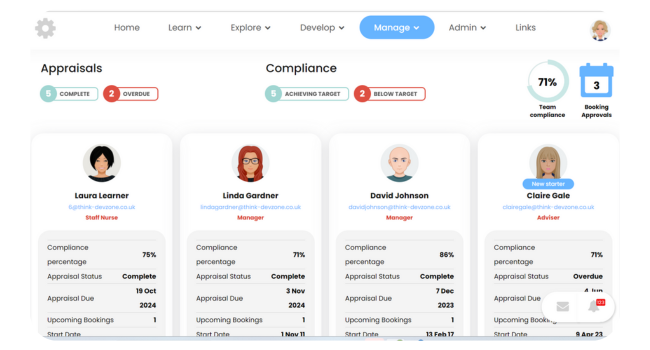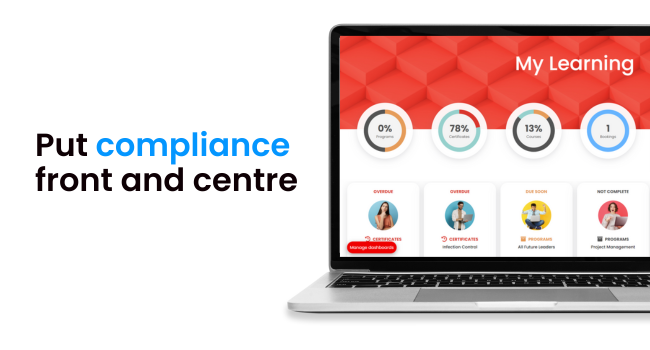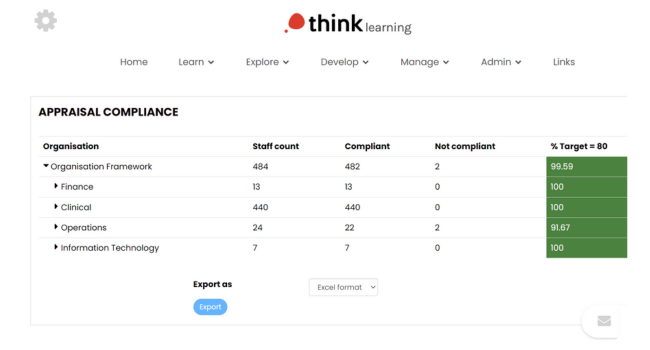
Healthcare compliance is a necessity, but it can sometimes feel difficult to get it done to the level you want. We run you through what it is and how to do it well.
The healthcare sector in the UK has been under mounting pressure, particularly over the last few years.
And it’s no surprise.
COVID-19 forced workers to the front line, and patient care has never been so important.
But while pressure rose, so did employee attrition, increasing from 9.5% to 12.6% in just two years.
Staff shortages continue to be an issue in the NHS too. While staff numbers are varying, the biggest concern is the growing number of vacancies that are being left unfilled.
As the population grows and further strain is put onto the NHS, more staff are needed to make up the difference and take some of the load.
Compliance is one extra task for these already strained workers. So how can L&D support the load?
In this blog, we’ll go through:
- What healthcare compliance is
- Why healthcare compliance is so important
- Who is responsible for compliance
- How to do healthcare compliance better
Let’s get started.
What is healthcare compliance?
Healthcare compliance is the process of following rules and regulations that relate to healthcare practices.
Related: Complete guide to compliance [free pdf]
Compliance in healthcare is ensured by regular review via training and exams to keep clinical workers up to date.
Compliance in healthcare can cover a wide range of internal and external rules. But it mostly comes down to patient safety and data security.
💡Pro Tip
We’re experts when it comes to delivering compliance solutions that drive higher engagement. Book a demo with our team to see how you can automatically report on compliance numbers and improve your stats.
Revolutionise your compliance
Why is healthcare compliance so important?
Every organisation has some level of compliance in place so that they operate smoothly. Healthcare compliance allows operations to run smoothly and ensures that clinical staff follow set procedures and understand expectations.
Of course, compliance in healthcare comes with higher stakes than other industries as patient safety is a potential risk should proper procedure not be followed.
By following these standards, healthcare organisations can offer and improve their quality of care.
Not only this, but violations of compliance can result in lawsuits, fines and loss of licenses. Having a high rate of compliance can result in lower insurance rates too, so there are plenty of advantages to prioritising healthcare compliance.
Who is responsible for healthcare compliance?
Compliance is everyone’s responsibility within the healthcare sector.
While the learning and development team will likely manage the learning and training, and work to encourage staff to complete it, it’s up to every worker to do their part.
🚀 Pro Tip
Do you struggle to pull historic compliance data for your new starters? Our smart tools work to automatically update your new starter’s compliance data so you can keep track.
Book a demo to see it in action
With ranging due dates and a whole host of training to get through, it can be tricky to manage your compliance rates.
This is where we come in.
How to do healthcare compliance better
Managing compliance in an LMS like Think, is the easiest way to keep track of gaps in your compliance rates and update your learning.
Here are a few reasons to consider switching to Think for better compliance:
- Automatically assign users to courses
- Put compliance at the centre of your LMS
- Smarter compliance reporting
- Easily integrate your tools
- Nudge users to prioritise compliance
Let’s look at these in more detail:
Auto-assign users to compliance courses
When new employees start, or as they progress, you will need to add them to the right compliance course for their job role.
When you’re dealing with hundreds, or even thousands, of staff, this can quickly become tricky.
With Think, you can auto-enrol your employees based on parameters and audience profiles pulled from your HR tool.

Put compliance front and centre
Completing compliance courses can easily wind-up bottom of the priority list.
With our easy-to-configure LMS, you can put compliance front and centre on your employees ‘ dashboards.

Pull real-time compliance reports
Access a range of useful reports and get instant access to compliance rates. There are a range of radials and reports to highlight compliance.
This includes a report where you can see compliance by team and break it down to individual levels.

Easily integrate all of your tools
Your HR tool, LMS and active directory should all be linked. But many tools struggle to integrate and connect data.
With Think, you can seamlessly flow data in and out of your LMS and can even create a single sign-on.
The Think LMS will pull data (new or updated) from your HR tool and automatically update the corresponding user in the LMS.
So, if a user changes job role, this will be reflected in your LMS and that employee will be automatically subscribed to the relevant compliance courses.
Send automatic reminders and notifications
The Think LMS will automatically send you email reports so you, and managers can see who is behind when it comes to compliance.
We can also incorporate ThinkNudge to your LMS to remind and notify users to get their courses completed by certain due dates.
Get started with Think compliance
Sound good? Compliance can quickly become a logistical headache as you battle admin and lack of engagement.
But with Think in place, jobs that previously took hours take mere minutes meaning you can spend more time on what truly matters, chasing complete compliance.
Book a demo to see our platform and all of our solutions in practice. We don’t just support compliance, we can also help with performance management, learner engagement, onboarding and much more.

